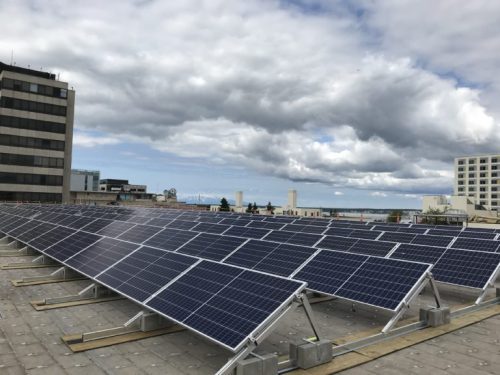
In early June, former State Senator Lesil McGuire wrote an ADN opinion piece entitled Energy is a building block of Alaska’s future. It was a happy little piece that made the case that the federal infrastructure legislation making its way through congress should be used for new renewable energy projects in Alaska as a way “… to bring jobs to every corner of the state.”
Nice sentiment but unreasonable. Here’s why: Her recommended forms of energy generation, wind, wave (tidal), solar, geothermal and (small) hydro are simply not reliable enough to rely upon statewide. I will focus primarily on wind and solar in this piece.
We Americans, and the rest of the world have learned a bit about renewables, particularly wind, over the last couple decades. These basic lessons which also apply to solar include the following:
- Wind is unreliable
- Wind is expensive
- Wind requires storage
- Wind requires backup generation
- Worst of all, embracing wind as foundational piece of statewide or national energy infrastructure makes your entire energy grid increasingly fragile, brittle, and subject to blackouts at unexpected times.
We even have a number for planning purposes. When the total penetration of renewables (usually wind and solar) in an energy grid gets around 20% of installed capacity, the blackouts will follow.
Who has learned that lesson in the last decade?
Texas did in February, with an installed capacity of 13 – 25% (depending on whose numbers you believe) of all statewide capacity. A couple very cold fronts blew through and shut down the wind. Blackouts quickly followed. There were other failures that made the problem worse. But if all the money happily spent on installing gigawatts of wind generators were spent on increasing reliability, building reactors, or freeze protecting natural gas wells, no blackouts. Instead, they end up with dead people and billions of dollars of frozen pipes to repair.
Germany has also been replacing reliable coal and nuclear generation with wind and solar. Last winter was very hard, long, dark and cold. Germany has been shuttering coal and nuclear generation, replacing them with wind and solar. They’ve already seen the expected spike in energy costs. And the warnings and threats of blackouts are becoming increasingly dire. There is no Plan B contemplated.
California has a goal of going to zero CO2 emissions by 2050, 80% of 1990 CO2 emissions by 2030. The renewables cheerleaders believe it can be done entirely with wind and solar, so they are busily shutting down all the reactors and other generation they can. As we know, the blackouts have been taking place in state for a few years, turning electrical availability in Cali to third-world reliability levels. Willis Eschenback, a numbers guy who writes in both Watts Up With That and Skating Under the Ice did an analysis of Cali’s move to zero emissions a month ago in WUWT. Bottom line is you can’t there from here.
In order to move to 80% CO2 emissions reduction by 2030, Cali will need 307 GW of generation. A typical nuclear power plant (Diablo Canyon for example) supplies 2.3 GW. This means that they need to site, permit, license, manufacture, build, test and connect to the grid a 2 GW nuclear plant every 3 weeks from now until then. In the US, the timeline for a new nuclear plant is typically over a decade and it’s been a while since a new one has come online – 2016 and 1996 for the most recent two. If you want to do this with wind, you need 1,000 2 MW wind turbines installed every single week between now and 2030. If you want to do it with solar, you need 83 km2 of new solar panels installed every single week between now and 2030.
Any wonder these idiots are getting blackouts?
Actual vs installed generation for wind and solar are wildly different. Worldwide data demonstrates that wind generates a mere 26% of its installed capacity. Solar is worse at 14%. This means with wind, you only get output a quarter the size of what you installed. Solar is even worse, with an output a seventh of installed capacity. With both, you have to have spinning backup generation and storage ready to go at a moment’s notice.
There are much better ways to get reliable energy here in Alaska than wind and solar. Generation IV nuclear, coal / natural gas to liquids (Fischer – Tropsch), and big hydro (Watana) all come to mind. While renewables may indeed bring jobs, those jobs will be more closely tied to repairing the damage from rolling blackouts due to the lack of wind and solar reliability than anything else.
We can do better than this. And we will unless we allow the pursuit of pixie dust, good intentions, and feel-good solutions completely divorced from actual data or economics to carry the day. Lesil ought to know better. Sadly, she and her fellow travelers in the renewables world make a moral case (in their mind) of not knowing any better, leading us down a very dangerous primrose path to energy unreliability.
With renewables, energy will be unreliable, but at least it will be expensive and destructive of existing energy systems in Alaska. Nothing like freezing in the dark to move civilization forward.
Alex Gimarc lives in Anchorage since retiring from the military in 1997. His interests include science and technology, environment, energy, economics, military affairs, fishing and disabilities policies. His weekly column “Interesting Items” is a summary of news stories with substantive Alaska-themed topics. He was a small business owner and Information Technology professional.






